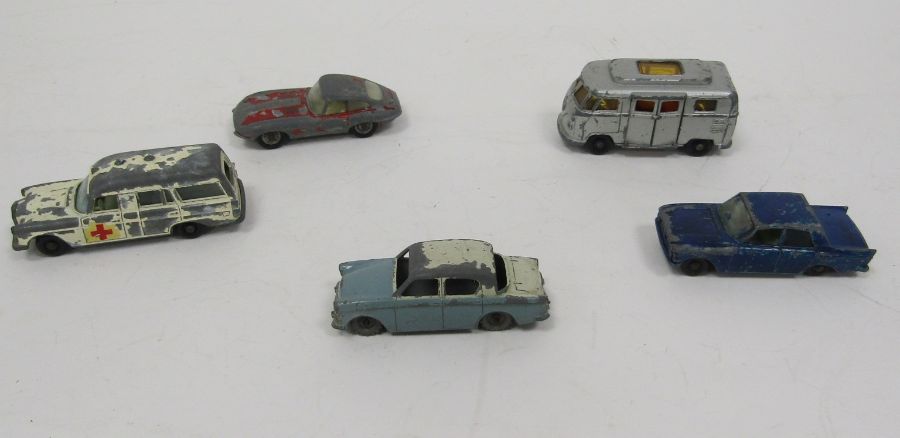In the early 1960s, both the Royal Marines, then largely based aboard commando carriers, and the British Army required a vehicle that could be carried by air. They had taken delivery of the Westland Wessex helicopter, which could carry an 1140 kg load slung beneath. The smallest Land Rover available at the time was a Series IIA 88 inch wheelbase, which was too heavy. A new modification to the basic Series IIA was devised by making many body components easily detachable and removing many non-essential items. The result was the Land Rover Half-Ton, known widely as theLightweightorAirportable. In practice, to reduce weight sufficiently for the helicopters of the day to lift them in combat conditions, the tilt and sticks, the upper parts of the body, the doors and windscreen were removed, to be refitted later. The most significant change, however, was a reduction in width by 4 inch, by redesigning the standard Series IIA axles and fitting shorter half-shafts, which meant it would fit on a standard pallet. Complete, the Lightweight IIA weighed 1,202 kg, over the specified weight and heavier in fact than a 'standard' Land Rover. The termLightweightwas, therefore, confusing. However, with the removable body panels taken-off it was below the limit. Since improvements to the helicopters meant more lift was available, the MoD accepted it for use. The first production models were completed on 11 November 1968, with the first 1500 distinguishable by having the headlights in the grill panel, including the car on offer today. This example was produced on 22 nd January 1969 and left the factory on the 30 th January 1969 to Central Vehicle Depot (CVD) in Feltham. The car is supplied with a copy of the "B" vehicle data card with its military service history and after Feltham, the Land Rover headed over to CVD Hilton on the 7 th November 1969. On 21 st March 1973, it was in service with the 8 th Signal Regiment and subsequently released from military service in 1975. Over the last 2 years, this Lightweight has undergone a rebuild on a new galvanised chassis which has been painted with the car subjected to a full respray; a new interior was fitted along with a new canvas roof. With an MoT test certificate valid until January 2018, this is a charming example of an early Lightweight and a particularly rare example with the grill mounted headlights.
In the early 1960s, both the Royal Marines, then largely based aboard commando carriers, and the British Army required a vehicle that could be carried by air. They had taken delivery of the Westland Wessex helicopter, which could carry an 1140 kg load slung beneath. The smallest Land Rover available at the time was a Series IIA 88 inch wheelbase, which was too heavy. A new modification to the basic Series IIA was devised by making many body components easily detachable and removing many non-essential items. The result was the Land Rover Half-Ton, known widely as theLightweightorAirportable. In practice, to reduce weight sufficiently for the helicopters of the day to lift them in combat conditions, the tilt and sticks, the upper parts of the body, the doors and windscreen were removed, to be refitted later. The most significant change, however, was a reduction in width by 4 inch, by redesigning the standard Series IIA axles and fitting shorter half-shafts, which meant it would fit on a standard pallet. Complete, the Lightweight IIA weighed 1,202 kg, over the specified weight and heavier in fact than a 'standard' Land Rover. The termLightweightwas, therefore, confusing. However, with the removable body panels taken-off it was below the limit. Since improvements to the helicopters meant more lift was available, the MoD accepted it for use. The first production models were completed on 11 November 1968, with the first 1500 distinguishable by having the headlights in the grill panel, including the car on offer today. This example was produced on 22 nd January 1969 and left the factory on the 30 th January 1969 to Central Vehicle Depot (CVD) in Feltham. The car is supplied with a copy of the "B" vehicle data card with its military service history and after Feltham, the Land Rover headed over to CVD Hilton on the 7 th November 1969. On 21 st March 1973, it was in service with the 8 th Signal Regiment and subsequently released from military service in 1975. Over the last 2 years, this Lightweight has undergone a rebuild on a new galvanised chassis which has been painted with the car subjected to a full respray; a new interior was fitted along with a new canvas roof. With an MoT test certificate valid until January 2018, this is a charming example of an early Lightweight and a particularly rare example with the grill mounted headlights.















Testen Sie LotSearch und seine Premium-Features 7 Tage - ohne Kosten!
Lassen Sie sich automatisch über neue Objekte in kommenden Auktionen benachrichtigen.
Suchauftrag anlegen